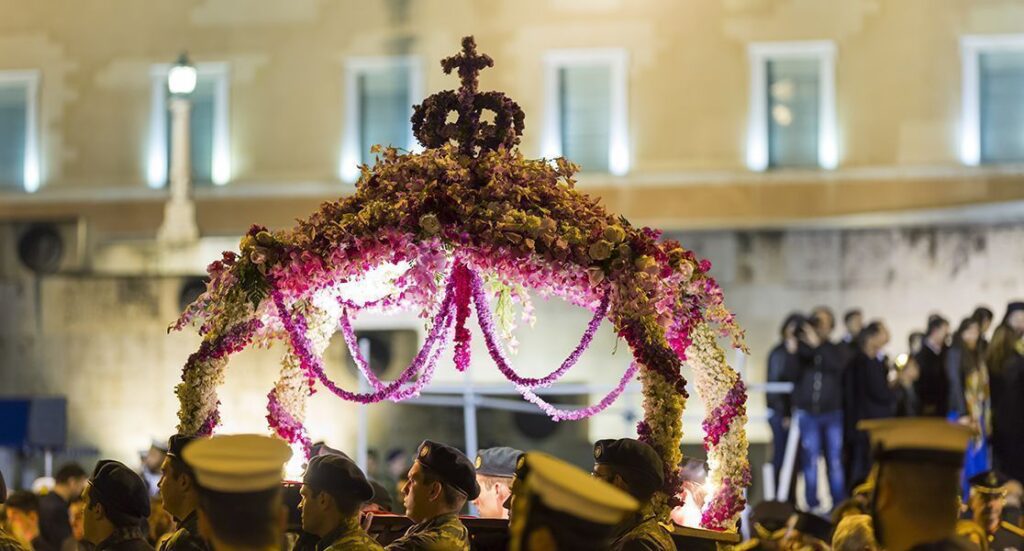As I write, it is April 2024. In the UK, Easter celebrations are over. Christ has risen. Here in Greece, Jesus has not yet entered Jerusalem. Why? Western and Orthodox Easter dates differ for two main reasons. First, the days of Easter, unlike Christmas, are not fixed. Second, the calendars used to calculate the date of Easter are different. The Western Church (Catholic and Protestant) uses the Gregorian calendar. The Orthodox Church uses the Julian calendar.
The Greek word for Easter,‘Πάσχα’ (Pascha) means ‘Passover’. It is a reference to theJewish celebration of God settingthe Israelites free from slavery in Egypt. Recorded in the Bible (Exodus 11: 1-12:36), God sent the ‘Destroyer’ (the Angel of Death in some English translations) to kill every firstborn man and beast in Egypt. God told the Israelites to paint the blood of a sacrificed lamb on the doorposts of their houses. On seeing the blood, the Angel of Death would ‘pass over’ the house and the firstborn would live.

Jesus was crucified, in Jerusalem, at the time of the Passover. In Christian tradition, the Old Testament Passover and the blood of the lamb symbolise Christ’s New Testament sacrifice for the sins of mankind. The Passover freed the Israelites from slavery in Egypt. Christ saves us from the slavery of sin.
The date of the Jewish Passover changes. It coincides with the first full moon in the month of Nisan, the first month of Spring in the Jewish calendar. At the Council of Nicaea in 325 AD, to fix the date of Easter as closely as possible to the date of the crucifixion of Christ, the Church leaders had to reconcile the Jewish calendar, which follows the lunar cycle and fixes the date according to the position of the moon, with the Julian calendar, then used in the Roman Empire, which follows the solar cycle and fixes the date according to the position of the Sun in relation to the planets and stars.
It wasn’t easy but they did it. They agreed that Easter would fall on the Sunday after the first full moon after the Spring equinox (the point at which the Sun is over the Earth’s equator and the days are of equal length), whichthe astronomers calculated to be 21 March. The English word ‘Easter’ may originate from ‘Eostre’, a pre-Christian goddess of Spring.
The difficulty of linking Easter with Passover was solved but, many years later, another problem arose. The Julian calendar, devised under and named after Julius Caesar, in 45 BC, calculated the length of the year as 365 and a quarter days. It introduced a leap year every four years to align the days and dates of the year with the seasons and the times of sunrise and sunset. This really mattered in an agrarian society, with no electricity and dependant on natural light.
The problem was that the Julian calendar overestimated the length of the year by 11 minutes and 14 seconds. That’s not much, but, over time, it adds up. Some 1200 years later the dates of the year were about 10 days out of alignment with the changes of season and predicted times of sunrise and sunset. To realign the seasons with the dates, in 1582, Pope Gregory XIII introduced the new Gregorian calendar, modestly named after himself.

Astronomically more accurate than the Julian calendar, the Gregorian calendar is the one widely used across the world today, but resistance to the Pope and the Catholic Church meant that its adoption was not immediate or universal. Catholic countries, such as France, Spain and Portugal quickly adopted the Gregorian calendar. They moved their date forward 10 days and, in 1582, Sunday, 9 December was followed by Monday, 20 December. Other countries took longer. The Protestant UK adopted the Gregorian calendar in 1752. A change of 11 days saw 2 September followed by 14 September in that year. This caused riots in England as people feared that their lives had been reduced by 11 days.Greece adopted the Gregorian calendar in 1923, with a change of 13 days that saw Wednesday, 15 February followed by Thursday, 1 March in that year.
Both the Western and Orthodox Churches calculate Easter as the first Sunday after the first full moon after the Spring equinox on 21 March. But it depends on which ‘21 March’ you use. The Gregorian calendar is aligned with the astronomical event of the Spring equinox, which takes place on either 20 or 21 March.
However, the Orthodox Church does not recognise the authority of the Pope or the Gregorian calendar and bases its calculation on the 21 March according to the Julian calendar. The 13-day difference between the two calendars (which will increase to 14 days by the year 2100), means that 21 March in the Julian calendar, corresponds to 3 April in the Gregorian calendar. Consequently, the first full moon after ’21 March’ in the Julian calendar can only come after 3 April in the Gregorian calendar. This is why Orthodox Easter can be on the same day as, but never before, Western Easter.
Confused? I bet you wish that you had never asked.
In effect, the date of Easter does not matter that much. The real date of Christ’s crucifixion is lost to history, What is important is the celebration of the death and resurrection of Jesus Christ, if you believe in the Christian tradition, or the arrival of warmer and longer days with the Spring if you don’t. And that we all get some time off!



